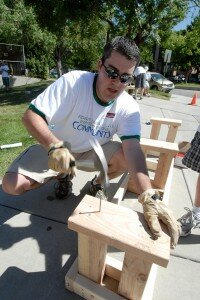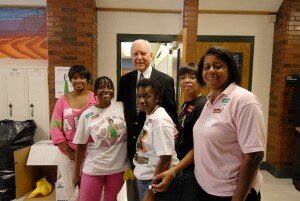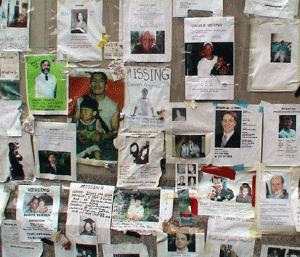 As the 5th anniversary of Hurricane Katrina approaches, our minds our on volunteer disaster response and we hope that you’re involved in one of the Citizen Gulf events taking place all around the nation today.
As the 5th anniversary of Hurricane Katrina approaches, our minds our on volunteer disaster response and we hope that you’re involved in one of the Citizen Gulf events taking place all around the nation today.
Are you ready to lead volunteers in the event of a local, national or international disaster?
Here are some disaster response roles volunteers can play.
Are you prepared?
1. Disaster Response Coordinator:
Regularly attends local emergency management meetings and affiliates the coordinating agency with the local Voluntary Organizations Active in Disaster (VOAD), Interfaith or other local disaster coalition. Educates the member organizations of the VOAD or Interfaith regarding the coordinating agency’s (CA) role of referring unaffiliated volunteers to them during disaster recovery. Gathers information from VOAD members about anticipated disaster volunteer needs and then builds a network of civic, fraternal and other groups to encourage their members to affiliate with a local disaster response organization. Develops a disaster volunteer referral plan and gathers supplies needed to open a volunteer reception center— identifies location for reception center; arranges transportation of needed equipment; recruits, trains and orients volunteer staff to help operate the reception center. Develops a plan to transport volunteers from the reception center to the worksites.
2. Coordinating Agency Member:
Works with the disaster response coordinator to register, refer and document unaffiliated disaster volunteers. Develops a public information plan for letting potential spontaneous volunteers know how they can get involved before a disaster occurs. Engages local businesses in planning to donate goods and services to future response and recovery efforts.
 3. Disaster Information Developer/Distributor:
3. Disaster Information Developer/Distributor:
Helps to create information material in various disaster preparedness areas for family, youth, seniors, etc. This can include individual, family and community preparedness. Distributes materials to appropriate audiences.
4. Needs Assessment Conductor:
Assesses the hazards and mitigation needs of the community and then communicates them to the Disaster Resistant Community Planning Committee so it can address those needs.
5. Capacity Builder for Reconstruction:
Makes the appropriate partnerships with corporations and organizations involved in construction to ensure effective clean up and rebuilding for recovery efforts.
6. Financial Advisor/Representative:
Takes necessary actions to evaluate potential mitigation and disaster recovery costs and then seeks out methods of fundraising and partnership development to help pay for mitigation and disaster efforts.
Preparedness Roles
 7. Community Emergency Response Team (C.E.R.T) Volunteer:
7. Community Emergency Response Team (C.E.R.T) Volunteer:
Assists others in their neighborhoods or workplaces following an event and can take a more active role in preparing their communities. Understands basic disaster response skills, such as fire safety, light search and rescue, and disaster medical operations. Gives critical support to first responders, provides immediate assistance to victims and organizes spontaneous volunteers at a disaster site. Helps improve the safety of the community before disasters happen.
8. Community Emergency Response Team (C.E.R.T) Trainer:
Completes Train-the-Trainer course conducted by the state training office for emergency management or the Federal Emergency Management Agency’s (FEMA) Emergency Management Institute (EMI) in Emmitsburg, MD. Studies disaster preparedness, disaster fire suppression, basic disaster medical operations, and light search and rescue operations and educates C.E.R.T. volunteers.
9. Medical Reserve Corps (MRC) Volunteer:
Coordinates with existing local emergency response programs and supplements existing community public health initiatives, such as outreach and prevention, immunization programs, blood drives, case management, care planning and other efforts. May deliver necessary public health services during a crisis, assist emergency response teams with patients, or provide care directly to those with less-serious injuries and other health-related issues.
 10. Neighborhood Watch Program Volunteer:
10. Neighborhood Watch Program Volunteer:
Completes training about terrorism awareness and the existing crime prevention mission and aims to bring residents together to focus on emergency preparedness and emergency response training.
11. Volunteer in Police Service (VIPS):
Helps supplement and support officers and civilian personnel by allowing them to concentrate on their primary duties. May perform clerical tasks, serve as an extra set of “eyes and ears,” assist with search and rescue activities, and write citations for accessible parking violations. Helps the police department fulfill its duties in the event of a disaster.
12. Community Disaster Educator:
Helps keep families and individuals safe. Presents and distributes important disaster preparedness material at local health fairs and information booths and gives lectures and presentations to interested groups.
Response Roles
 13. Volunteer Reception Center (VRC) Director:
13. Volunteer Reception Center (VRC) Director:
Oversees the VRC operation. Clearly designates one entrance and one exit. Sets up the room for efficient flow of volunteers and information. Briefs and assigns tasks to staff and volunteers of the center. Monitors the operation and makes changes when necessary. Meets and thanks volunteers who help in the VRC and instructs them to sign in and out.
14. Volunteer Reception Center (VRC) Greeter:
Provides instruction sheets to volunteers, asks them to complete registration forms and gives them a brief orientation to the registration process.
15. Volunteer Reception Center (VRC) Interviewer:
Interviews volunteers and gives them referral forms. Explains where and to whom volunteers should report for duty.
16. Volunteer Reception Center (VRC) Data Coordinator and Entry Staff:
Records volunteer referrals and communicates, as needed, with requesting agencies so that when needs have been met, requests can be closed out. Enters Requests for Volunteers and Volunteer Registration Forms into the computer. Prints out updated lists of unfilled requests as needed.
 17. Volunteer Reception Center (VRC) Volunteer Identification Staff:
17. Volunteer Reception Center (VRC) Volunteer Identification Staff:
Attaches wristbands volunteers that contain the volunteer’s name, the agency or site to which the volunteer was referred, and the date(s) on which the volunteer expects to work.
18. Volunteer Reception Center (VRC) Safety Trainer:
Documents the attendance of each volunteer and presents a prepared safety briefing appropriate to the specific disaster event.
19. Volunteer Reception Center (VRC) Specific Job Trainer:
Provides specific job training to each worksite or function before volunteers depart for their work areas.
20. Volunteer Reception Center (VRC) Phone Bank Operator:
Takes calls from individuals and groups wishing to volunteer and from organizations needing volunteers. Records each call and posts information on the request board or forwards details to the data coordinator.
 21. Public Information Officer:
21. Public Information Officer:
Makes statements to the media about the center’s operation. Serves as the only contact with media and should be a trained professional who only delivers information approved by the VRC director.
22. VRC Runner:
Attends to VRC stations that have raised a small flag summoning assistance. Posts new requests for volunteers on the request board, carries information from one station to another, escorts guests and delivers supplies to the stations.
23. Worksite Supervisor:
Maintains a supply of volunteer sign-in-sheets at each volunteer worksite. Conducts a safety briefing as each group of volunteers arrives, regarding the specific hazards at the site. Has all volunteers read the statement at the top of the sign-in sheet and sign in, recording their time of arrival and departure each day. Turns in all sign-in sheets to a designated supervisor who will turn them into the budget department.
24. Shelter Volunteer:
Helps with the operation of shelter needs.
 25. Language Translator:
25. Language Translator:
Translates disaster response and recovery information to individuals who do not understand English.
26. Transportation Driver/Dispatcher:
Helps people who have no reliable means of transportation get to and from medical appointments. Uses Red Cross vehicles to transport clients to and from area hospitals, physicians’ offices and medical facilities. Coordinates appointments and schedules.
27. Volunteer Transportation Director:
Helps to put up road signs and clearly marked directions to worksites, donation warehouses and the reception center. Monitors control checkpoints where trucks and other transport vehicles may be inspected, scheduled, turned back or directed to a designated reception center, warehouse or distribution center.
28. Amateur Radio Operator:
Provides backup communications in the event of a failure of the government system. Supplements communications at large disasters and emergencies.
29. Animal Rescuer:
Helps evacuate and rescue deserted animals. Completes training in small and large animal handling and care.
 30. Security Personnel:
30. Security Personnel:
Protects worksites from unauthorized visitors and protects victims and other citizens from violent behavior and outbreaks in times of disaster. Aids in police efforts.
Recovery Roles
31. Volunteer Disaster Damage Assessor:
Provides disaster damage assessment support to a large state or national disaster relief operation. Identifies and notes exterior damage to homes within 72 hours of the disaster. Completes appropriate forms, reports and records in a timely manner. Completes necessary training to stay up to date on changes in function. Participates in disaster preparedness exercises. Must be efficient, organized, observant, flexible, adaptable to change, accept direction and have attention to detail.
32. Heavy Equipment Operator:
Runs and operates heavy equipment as part of debris removal and reconstruction.
33. Debris Clean-up Crew:
Helps move debris off the streets to allow for traffic to pass through.
34. Construction Volunteer:
Helps in reconstruction efforts.
35. Food and Donations Distributor:
Helps distribute meals, clothing, etc., to victims of a disaster.
 36. Disaster Health/Mental Health Volunteer:
36. Disaster Health/Mental Health Volunteer:
Helps disaster victims and workers involved with the disaster relief effort with health-related emergencies and provides counseling in shelters, service centers and during home visits. Must be licensed professionals.
37. Warehouse Volunteer:
Sorts donated non-perishable food products and repacks it for distribution to emergency food providers in communities.
38. Donation Coordination Team Volunteer:
Manages donations phone bank. Processes offers from the public. Conducts donations intelligence. Works to include emerging relief organizations. Ensures effective logistics procedures are in place. Maintains a database on donated goods and services. Determines the needs of donations and services. Identify staging areas, distribution centers and ports of entry.
39. Donations Coordinator:
Works with the public information officer to plan and implement public awareness information. Coordinates with donations management and other state agencies as necessary. Ensures effective communications are in place. Determines best way to dispose of excess donations—recycle, redistributed or donated to other locations.
Originally published by the Points of Light Foundation. Revised by HandsOn Network in 2010.

 By Kristen Cambell, Director of Programs and New Media at the National Conference on Citizenship
By Kristen Cambell, Director of Programs and New Media at the National Conference on Citizenship Consumers are letting their wallets do the talking in conveying the importance of corporate citizenship; 75 percent of consumers say they are more likely to purchase products or services from a company after reading its responsibility agenda.
Consumers are letting their wallets do the talking in conveying the importance of corporate citizenship; 75 percent of consumers say they are more likely to purchase products or services from a company after reading its responsibility agenda. When you engage others in your volunteer activity, you automatically become a service leader.
When you engage others in your volunteer activity, you automatically become a service leader.
 by Tricia Thompson, Manager of Volunteer Leader Training,
by Tricia Thompson, Manager of Volunteer Leader Training,  1. Determine What You Can Contribute
1. Determine What You Can Contribute

 8. Evaluate Outcomes and Measure Success
8. Evaluate Outcomes and Measure Success
 As some of you may know, HandsOn Network and Fidelity Investments are partnering in an amazing effort that is revitalizing the learning environments in 11 middle schools across the nation. In locations ranging from Nashua, NH, to Albuquerque, NM, Fidelity employees are working with HandsOn action centers and partners on local Transformation Days, executing projects chosen with each school’s teachers, students, parents, and community.
As some of you may know, HandsOn Network and Fidelity Investments are partnering in an amazing effort that is revitalizing the learning environments in 11 middle schools across the nation. In locations ranging from Nashua, NH, to Albuquerque, NM, Fidelity employees are working with HandsOn action centers and partners on local Transformation Days, executing projects chosen with each school’s teachers, students, parents, and community. The senator’s presence had particular resonance, since he and the late Senator Ted Kennedy were instrumental in passing the bipartisan Serve America Act last year. The Act is the greatest expansion of national service in many decades. Last year Points of Light Institute honored both senators with the Points of Light Lifetime of Leadership Award for Volunteerism and Service, recognizing their commitment and leadership in creating civic change through service. “Seeing individuals like you, working hard in the community…is what we thought would happen when we passed the Serve America Act,” said Senator Hatch to the volunteers.
The senator’s presence had particular resonance, since he and the late Senator Ted Kennedy were instrumental in passing the bipartisan Serve America Act last year. The Act is the greatest expansion of national service in many decades. Last year Points of Light Institute honored both senators with the Points of Light Lifetime of Leadership Award for Volunteerism and Service, recognizing their commitment and leadership in creating civic change through service. “Seeing individuals like you, working hard in the community…is what we thought would happen when we passed the Serve America Act,” said Senator Hatch to the volunteers.

 I remember hand made signs seeking those who were missing. “Have you seen…?”
I remember hand made signs seeking those who were missing. “Have you seen…?”
 By Rahul Prakash, Chief Operating Officer,
By Rahul Prakash, Chief Operating Officer,  by Jamie S. Dent, AmeriCorps Program Manager at
by Jamie S. Dent, AmeriCorps Program Manager at 
